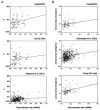A neutral explanation for the correlation of diversity with recombination rates in humans
- PMID: 12740762
- PMCID: PMC1180312
- DOI: 10.1086/375657
A neutral explanation for the correlation of diversity with recombination rates in humans
Abstract
One of the most striking findings to emerge from the study of genomic patterns of variation is that regions with lower recombination rates tend to have lower levels of intraspecific diversity but not of interspecies divergence. This uncoupling of variation within and between species has been widely interpreted as evidence that natural selection shapes patterns of genetic variability genomewide. We revisited the relationship between diversity, divergence, and recombination in humans, using data from closely related species and better estimates of recombination rates than previously available. We show that regions that experience less recombination have reduced divergence to chimpanzee and to baboon, as well as lower levels of diversity. This observation suggests that mutation and recombination are associated processes in humans, so that the positive correlation between diversity and recombination may have a purely neutral explanation. Consistent with this hypothesis, diversity levels no longer increase significantly with recombination rates after correction for divergence to chimpanzee.
Figures



Similar articles
-
Why do human diversity levels vary at a megabase scale?Genome Res. 2005 Sep;15(9):1222-31. doi: 10.1101/gr.3461105. Genome Res. 2005. PMID: 16140990 Free PMC article.
-
Natural selection affects multiple aspects of genetic variation at putatively neutral sites across the human genome.PLoS Genet. 2011 Oct;7(10):e1002326. doi: 10.1371/journal.pgen.1002326. Epub 2011 Oct 13. PLoS Genet. 2011. PMID: 22022285 Free PMC article.
-
Human polymorphism and human-chimpanzee divergence in pseudoautosomal region correlate with local recombination rate.Gene. 2006 Mar 1;368:94-100. doi: 10.1016/j.gene.2005.10.020. Epub 2005 Dec 13. Gene. 2006. PMID: 16356662
-
Recombination rate variation in closely related species.Heredity (Edinb). 2011 Dec;107(6):496-508. doi: 10.1038/hdy.2011.44. Epub 2011 Jun 15. Heredity (Edinb). 2011. PMID: 21673743 Free PMC article. Review.
-
How can the low levels of DNA sequence variation in regions of the drosophila genome with low recombination rates be explained?Proc Natl Acad Sci U S A. 1994 Jul 19;91(15):6815-8. doi: 10.1073/pnas.91.15.6815. Proc Natl Acad Sci U S A. 1994. PMID: 8041702 Free PMC article. Review.
Cited by
-
Recombination drives vertebrate genome contraction.PLoS Genet. 2012;8(5):e1002680. doi: 10.1371/journal.pgen.1002680. Epub 2012 May 3. PLoS Genet. 2012. PMID: 22570634 Free PMC article.
-
Variable molecular clocks in hominoids.Proc Natl Acad Sci U S A. 2006 Jan 31;103(5):1370-5. doi: 10.1073/pnas.0510716103. Epub 2006 Jan 23. Proc Natl Acad Sci U S A. 2006. PMID: 16432233 Free PMC article.
-
The rate, not the spectrum, of base pair substitutions changes at a GC-content transition in the human NF1 gene region: implications for the evolution of the mammalian genome structure.Genetics. 2007 Jan;175(1):421-8. doi: 10.1534/genetics.106.064386. Epub 2006 Oct 22. Genetics. 2007. PMID: 17057231 Free PMC article.
-
On the association between chromosomal rearrangements and genic evolution in humans and chimpanzees.Genome Biol. 2007;8(10):R230. doi: 10.1186/gb-2007-8-10-r230. Genome Biol. 2007. PMID: 17971225 Free PMC article.
-
Characteristics, causes and evolutionary consequences of male-biased mutation.Proc Biol Sci. 2007 Jan 7;274(1606):1-10. doi: 10.1098/rspb.2006.3720. Proc Biol Sci. 2007. PMID: 17134994 Free PMC article. Review.
References
Electronic-Database Information
-
- GenBank, http://www.ncbi.nih.gov/Genbank/ (accessed, September 2002)
-
- NIEHS SNPs, http://egp.gs.washington.edu/ (accessed, October 2002)
-
- SeattleSNPs, http://pga.mbt.washington.edu/ (accessed, October 2002)
-
- UCSC Genome Bioinformatics, http://genome.ucsc.edu/
References
-
- Altschul SF, Gish W, Miller W, Myers EW, Lipman DJ (1990) Basic local alignment search tool. J Mol Biol 215:403–410 - PubMed
-
- Andolfatto P (2001) Adaptive hitchhiking effects on genome variability. Curr Opin Genet Dev 11:635–641 - PubMed
-
- Begun DJ, Aquadro CF (1992) Levels of naturally occurring DNA polymorphism correlate with recombination rates in D. melanogaster. Nature 356:519–520 - PubMed
MeSH terms
LinkOut - more resources
Full Text Sources
Other Literature Sources

